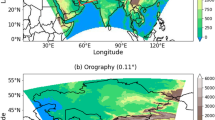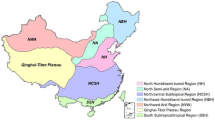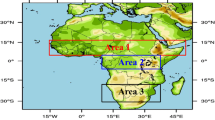Abstract
Vegetation is one of the most important parts of the Earth’s land surface system. To investigate the impact and uncertainty of multi-source vegetation data on climate simulations in East Asia, we have compared two Fractional Vegetation Cover (FVC) and five Leaf Area Index (LAI) products and then performed seven experiments from 1999 to 2018 with the WRF model. The results suggest that the sensitivity of vegetation climatology is large especially in south East Asia, with a maximum difference of 4 m2/m2 in LAI and 16% in FVC. For the mean temperature, the responses in East Asia are between ± 0.4 K, and the uncertainty over the Chinese Mainland gradually enhances with the rapid vegetation growth. The feedback of precipitation is highly heterogeneous with sensitivities ranging between ± 1 mm. For interannual variability, vegetation has a greater impact in summer and autumn. The uncertainty of temperature and precipitation in summer over the Chinese Mainland is 118 and 1754 times that in winter. In addition, the linear trend results also indicate that the maximum trend difference in temperature is around 0.04 K/a in eastern China, while the precipitation has a larger range of 0.04–0.10 mm/a in southern East Asia. Besides, the biophysical mechanism analysis suggests that vegetation impact on surface energy budget is mainly a competition between albedo feedback and moisture feedback, and the large differences in multi-source FVC and LAI are sufficient to simulate different or even opposite feedbacks.











Similar content being viewed by others
Availability of data and material
The datasets and material generated during and/or analyzed during the current study are available from the corresponding author on reasonable request.
References
Alkama R, Cescatti A (2016) Biophysical climate impacts of recent changes in global forest cover. Science 351:600–604
Baret F, Hagolle O, Geiger B et al (2007) LAI, fAPAR and fCover CYCLOPES global products derived from VEGETATION: Part 1: principles of the algorithm. Remote Sens Environ 110:275–286
Baret F, Weiss M, Lacaze R et al (2013) GEOV1: LAI and FAPAR essential climate variables and FCOVER global time series capitalizing over existing products. Part1: principles of development and production. Remote Sens Environ 137:299–309
Cao Q, Yu D, Georgescu M et al (2018) Substantial impacts of landscape changes on summer climate with major regional differences: the case of China. Sci Total Environ 625:416–427
Chen J, Jönsson P, Tamura M et al (2004) A simple method for reconstructing a high-quality NDVI time-series data set based on the Savitzky-Golay filter. Remote Sens Environ 91:332–344
Christidis N, Stott PA, Hegerl GC et al (2013) The role of land use change in the recent warming of daily extreme temperatures. Geophys Res Lett 40:589–594
Churkina G, Schimel D, Braswell BH et al (2005) Spatial analysis of growing season length control over net ecosystem exchange. Glob Change Biol 11:1777–1787
Claverie M, Matthews JL, Vermote EF et al (2016) A 30+ year AVHRR LAI and FAPAR climate data record: algorithm description and validation. Remote Sens 8:263
Cohen WB, Maiersperger TK, Yang Z et al (2003) Comparisons of land cover and LAI estimates derived from ETM+ and MODIS for four sites in North America: a quality assessment of 2000/2001 provisional MODIS products. Remote Sens Environ 88:233–255
de Noblet-Ducoudré N, Boisier J-P, Pitman A et al (2012) Determining robust impacts of land-use-induced land cover changes on surface climate over North America and Eurasia: results from the first set of LUCID experiments. J Clim 25:3261–3281
Deng F, Chen JM, Plummer S et al (2006) Algorithm for global leaf area index retrieval using satellite imagery. IEEE Trans Geosci Remote Sens 44:2219–2229
Duveiller G, Hooker J, Cescatti A (2018) The mark of vegetation change on Earth’s surface energy balance. Nat Commun 9:679
Fang H, Wei S, Jiang C et al (2012) Theoretical uncertainty analysis of global MODIS, CYCLOPES, and GLOBCARBON LAI products using a triple collocation method. Remote Sens Environ 124:610–621
Fang H, Jiang C, Li W et al (2013) Characterization and intercomparison of global moderate resolution leaf area index (LAI) products: analysis of climatologies and theoretical uncertainties. J Geophys Res Biogeosci 118:529–548
Gálos B, Hagemann S, Hänsler A et al (2013) Case study for the assessment of the biogeophysical effects of a potential afforestation in Europe. Carbon Balance Manag 8:3
Ge Q, Zhang X, Zheng J (2014) Simulated effects of vegetation increase/decrease on temperature changes from 1982 to 2000 across the Eastern China. Int J Climatol 34:187–196
Georgievski G, Hagemann S (2019) Characterizing uncertainties in the ESA-CCI land cover map of the epoch 2010 and their impacts on MPI-ESM climate simulations. Theoret Appl Climatol 137:1587–1603
Glotfelty T, Alapaty K, He J et al (2019) The weather research and forecasting model with aerosol-cloud interactions (WRF-ACI): development, evaluation, and initial application. Mon Weather Rev 147:1491–1511
Gutman GG (1991) Vegetation indices from AVHRR: an update and future prospects. Remote Sens Environ 35:121–136
He J, Yu Y, Yu L et al (2017) Impacts of uncertainty in land surface information on simulated surface temperature and precipitation over China. Int J Climatol 37:829–847
Hersbach H, Bell B, Berrisford P et al (2020) The ERA5 global reanalysis. Q J R Meteorol Soc 146:1999–2049
Hong S-Y, Noh Y, Dudhia J (2006) A new vertical diffusion package with an explicit treatment of entrainment processes. Mon Weather Rev 134:2318–2341
Iacono MJ, Delamere JS, Mlawer EJ et al (2008) Radiative forcing by long-lived greenhouse gases: calculations with the AER radiative transfer models. J Geophys Res Atmos. https://doi.org/10.1029/2008JD009944
Jeong SJ, Ho CH, Gim HJ et al (2011) Phenology shifts at start vs. end of growing season in temperate vegetation over the Northern Hemisphere for the period 1982–2008. Glob Change Biol 17:2385–2399
Jia K, Liang S, Liu S et al (2015) Global land surface fractional vegetation cover estimation using general regression neural networks from MODIS surface reflectance. IEEE Trans Geosci Remote Sens 53:4787–4796
Jia K, Yang L, Liang S et al (2018) Long-term Global Land Surface Satellite (GLASS) fractional vegetation cover product derived from MODIS and AVHRR Data. IEEE J Select Top Appl Earth Observ Remote Sens 12:508–518
Jia G, Shevliakova E, Artaxo P et al (2019) Land–climate interactions. In: Special report on climate change and land: an IPCC special report on climate change, desertification, land degradation, sustainable land management, food security, and greenhouse gas fluxes in terrestrial ecosystems, IPCC, pp 133–206
Jiang C, Ryu Y, Fang H et al (2017) Inconsistencies of interannual variability and trends in long-term satellite leaf area index products. Glob Change Biol 23:4133–4146
Jiao F, Liu H, Xu X et al (2020) Trend evolution of vegetation phenology in China during the period of 1981–2016. Remote Sens 12:572
Lian X, Jeong S, Park C-E et al (2022) Biophysical impacts of northern vegetation changes on seasonal warming patterns. Nat Commun 13:3925
Liang S, Zhao X, Liu S et al (2013) A long-term Global LAnd Surface Satellite (GLASS) data-set for environmental studies. Int J Digit Earth 6:5–33
Liu Y, Liu R, Chen JM (2012) Retrospective retrieval of long-term consistent global leaf area index (1981–2011) from combined AVHRR and MODIS data. J Geophys Res Biogeosci. https://doi.org/10.1029/2012JG002084
Liu Y, Li Y, Li S et al (2015) Spatial and temporal patterns of global NDVI trends: correlations with climate and human factors. Remote Sens 7:13233–13250
Mahowald N, Lo F, Zheng Y et al (2016) Projections of leaf area index in earth system models. Earth Syst Dyn 7:211–229
Meng X, Evans J, McCabe M (2014) The impact of observed vegetation changes on land–atmosphere feedbacks during drought. J Hydrometeorol 15:759–776
Meng X, Lyu S, Zhang T et al (2018) Simulated cold bias being improved by using MODIS time-varying albedo in the Tibetan Plateau in WRF model. Environ Res Lett 13:044028
Myneni RB, Hoffman S, Knyazikhin Y et al (2002) Global products of vegetation leaf area and fraction absorbed PAR from year one of MODIS data. Remote Sens Environ 83:214–231
Niu GY, Yang ZL, Mitchell KE et al (2011) The community Noah land surface model with multiparameterization options (Noah‐MP): 1. Model description and evaluation with local‐scale measurements. J Geophys Res Atmos 116
Notaro M, Liu Z, Williams JW (2006) Observed vegetation–climate feedbacks in the United States. J Clim 19:763–786
Park T, Ganguly S, Tømmervik H et al (2016) Changes in growing season duration and productivity of northern vegetation inferred from long-term remote sensing data. Environ Res Lett 11:084001
Piao S, Ciais P, Friedlingstein P et al (2008) Net carbon dioxide losses of northern ecosystems in response to autumn warming. Nature 451:49–52
Piao S, Liu Q, Chen A et al (2019) Plant phenology and global climate change: current progresses and challenges. Glob Change Biol 25:1922–1940
Piao S, Wang X, Park T et al (2020) Characteristics, drivers and feedbacks of global greening. Nat Rev Earth Environ 1:14–27
Pitman AJ, de Noblet-Ducoudré N, Cruz F et al (2009) Uncertainties in climate responses to past land cover change: first results from the LUCID intercomparison study. Geophys Res Lett. https://doi.org/10.1029/2009GL039076
Reed BC, Brown JF, VanderZee D et al (1994) Measuring phenological variability from satellite imagery. J Veg Sci 5:703–714
Shen X, Liu B, Henderson M et al (2022) Vegetation greening, extended growing seasons, and temperature feedbacks in warming temperate grasslands of China. J Clim 35:5103–5117
Skamarock W, Klemp J, Dudhia J et al (2008) A description of the advanced research WRF Version 3. NCAR Tech. Note NCAR/TN-475+ STR
Tang J, Niu X, Wang S et al (2016) Statistical downscaling and dynamical downscaling of regional climate in China: present climate evaluations and future climate projections. J Geophys Res Atmos 121:2110–2129
Thompson G, Field PR, Rasmussen RM et al (2008) Explicit forecasts of winter precipitation using an improved bulk microphysics scheme. Part II: implementation of a new snow parameterization. Mon Weather Rev 136:5095–5115
Verger A, Baret F, Weiss M (2014) Near real-time vegetation monitoring at global scale. IEEE J Select Top Appl Earth Observ Remote Sens 7:3473–3481
Verger A, Filella I, Baret F et al (2016) Vegetation baseline phenology from kilometric global LAI satellite products. Remote Sens Environ 178:1–14
White MA, de Beurs KM, Didan K et al (2009) Intercomparison, interpretation, and assessment of spring phenology in North America estimated from remote sensing for 1982–2006. Glob Change Biol 15:2335–2359
Windisch MG, Davin EL, Seneviratne SI (2021) Prioritizing forestation based on biogeochemical and local biogeophysical impacts. Nat Clim Chang 11:867–871
Wu J, Wang D, Li LZ et al (2022) Hydrological feedback from projected Earth greening in the 21st century. Sustain Horiz 1:100007
Xiao Z, Liang S, Wang J et al (2013) Use of general regression neural networks for generating the GLASS leaf area index product from time-series MODIS surface reflectance. IEEE Trans Geosci Remote Sens 52:209–223
Xiao Z, Liang S, Wang J et al (2016) Long-time-series global land surface satellite leaf area index product derived from MODIS and AVHRR surface reflectance. IEEE Trans Geosci Remote Sens 54:5301–5318
Yang ZL, Niu GY, Mitchell KE et al (2011) The community Noah land surface model with multiparameterization options (Noah‐MP): 2. Evaluation over global river basins. J Geophys Res Atmos 116
Yang T, Li Q, Chen X et al (2020) Improving snow simulation with more realistic vegetation parameters in a regional climate model in the Tianshan Mountains, Central Asia. J Hydrol 590:125525
Yu L, Liu Y, Liu T et al (2020) Impact of recent vegetation greening on temperature and precipitation over China. Agric for Meteorol 295:108197
Zeng Z, Piao S, Li LZ et al (2017) Climate mitigation from vegetation biophysical feedbacks during the past three decades. Nat Clim Chang 7:432–436
Zeng Z, Wang D, Yang L et al (2021) Deforestation-induced warming over tropical mountain regions regulated by elevation. Nat Geosci 14:23–29
Zhang Y, Peña-Arancibia JL, McVicar TR et al (2016) Multi-decadal trends in global terrestrial evapotranspiration and its components. Sci Rep 6:1–12
Zheng Y, Alapaty K, Herwehe JA et al (2016) Improving high-resolution weather forecasts using the Weather Research and Forecasting (WRF) Model with an updated Kain-Fritsch scheme. Mon Weather Rev 144:833–860
Zhu Z, Bi J, Pan Y et al (2013) Global data sets of vegetation leaf area index (LAI) 3g and fraction of photosynthetically active radiation (FPAR) 3g derived from global inventory modeling and mapping studies (GIMMS) normalized difference vegetation index (NDVI3g) for the period 1981 to 2011. Remote Sens 5:927–948
Zhu Z, Piao S, Myneni RB et al (2016) Greening of the Earth and its drivers. Nat Clim Chang 6:791–795
Acknowledgements
The work is jointly funded by the National Natural Science Foundation of China (42130602), the National Key Research and Development Program of China (2016YFA0600303) and the National Natural Science Foundation of China (41875124). This work is also supported by the Chinese Jiangsu Collaborative Innovation Center for Climate Change.
Funding
The work is jointly funded by the National Natural Science Foundation of China (42130602), the National Key Research and Development Program of China (2016YFA0600303) and the National Natural Science Foundation of China (41875124).
Author information
Authors and Affiliations
Contributions
All authors contributed to the study conception and design. Material preparation, data collection and analysis were performed by YY and JT. The first draft of the manuscript was written by YY and all authors commented on previous versions of the manuscript.
Corresponding author
Ethics declarations
Conflict of interest
The authors have no relevant financial or non-financial interests to disclose.
Ethics approval and consent to participate
Not applicable.
Consent for publication
All authors read and approved the final manuscript.
Additional information
Publisher's Note
Springer Nature remains neutral with regard to jurisdictional claims in published maps and institutional affiliations.
Rights and permissions
Springer Nature or its licensor (e.g. a society or other partner) holds exclusive rights to this article under a publishing agreement with the author(s) or other rightsholder(s); author self-archiving of the accepted manuscript version of this article is solely governed by the terms of such publishing agreement and applicable law.
About this article
Cite this article
Yan, Y., Tang, J. & Wang, S. Uncertainty of multi-source vegetation products on regional climate simulation in China. Clim Dyn 61, 2991–3008 (2023). https://doi.org/10.1007/s00382-023-06739-1
Received:
Accepted:
Published:
Issue Date:
DOI: https://doi.org/10.1007/s00382-023-06739-1




